Subaru B9 Tribeca 2006 User Manual

Foreword
Congratulations on choosing a SUBARU vehicle. This Owner’s Manual has all the information necessary to keep your SUBARU in excellent condition and to properly maintain the emission control system for minimizing emission pollutants. We urge you to read this manual carefully so that you may understand your vehicle and its operation. For information not found in this Owner’s Manual, such as details concerning repairs or adjustments, please contact the dealer from whom you purchased your SUBARU or the nearest SUBARU dealer.
The information, specifications and illustrations found in this manual are those in effect at the time of printing. FUJI HEAVY INDUSTRIES LTD. reserves the right to change specifications and designs at any time without prior notice and without incurring any obligation to make the same or similar changes on vehicles previously sold. This Owner’s Manual applies to all models and covers all equipment, including factory installed options. Some explanations, therefore may be for equipment not installed in your vehicle.
Please leave this manual in the vehicle at the time of resale. The next owner will need the information found herein.
FUJI HEAVY INDUSTRIES LTD., TOKYO, JAPAN



 is a registered trademark of FUJI HEAVY INDUSTRIES LTD. © copyright 2005 FUJI HEAVY INDUSTRIES LTD.
is a registered trademark of FUJI HEAVY INDUSTRIES LTD. © copyright 2005 FUJI HEAVY INDUSTRIES LTD.

000083 |
|
000084 |
|
|
|
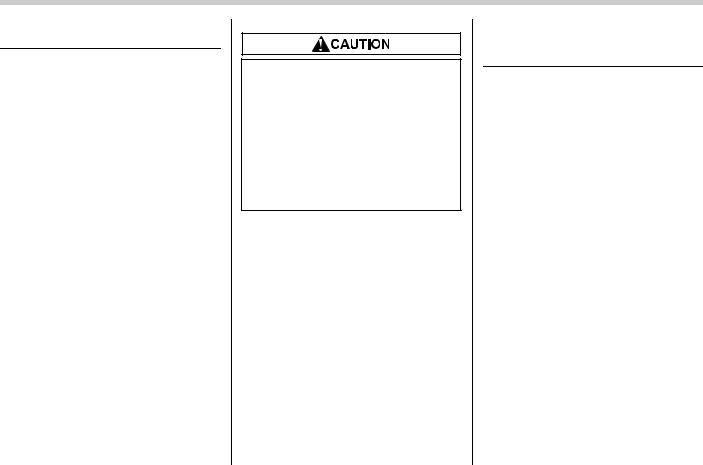
Warranties
Warranties for U.S.A.
All SUBARU vehicles distributed by Subaru of America, Inc. and sold at retail by an authorized SUBARU dealer in the United States come with the following warranties:
ySUBARU Limited Warranty
yEmission Control Systems Warranty
yEmissions Performance Warranty
All warranty information, including details of coverage and exclusions, is in the “Warranty and Maintenance Booklet”. Please read these warranties carefully.
T Warranties for Canada
All SUBARU vehicles distributed by Subaru Canada, Inc. and sold at retail by an authorized SUBARU dealer in Canada come with the following warranties:
ySUBARU Limited Warranty
yAnti-Corrosion Warranty
yEmission Control Warranty
All warranty information, including details of coverage and exclusions, is in the “Warranty and Service Booklet”. Please read these warranties carefully.
If your vehicle is equipped with a navigation system and/or Rear Seat Entertainment System, the displays contain mercury. Therefore, the displays of the navigation system and/ or Rear Seat Entertainment System must be removed before vehicle disposal. Once the displays have been removed, please reuse, recycle or dispose of them as hazardous waste.
1
How to use this owner’s manual
Using your Owner’s manual
Before you operate your vehicle, carefully read this manual. To protect yourself and extend the service life of your vehicle, follow the instructions in this manual. Failure to observe these instructions may result in serious injury and damage to your vehicle.
This manual is composed of fourteen chapters. Each chapter begins with a brief table of contents, so you can usually tell at a glance if that chapter contains the information you want.
Chapter 1: Seat, seatbelt and SRS airbags
This chapter informs you how to use the seat and seatbelt and contains precautions for the SRS airbags.
Chapter 2: Keys and doors
This chapter informs you how to operate the keys, locks and windows.
Chapter 3: Instruments and controls
This chapter informs you about the operation of instrument panel indicators and how to use the instruments and other switches.
Chapter 4: Climate control
This chapter informs you how to operate
– CONTINUED –

2
the climate control.
Chapter 5: Audio
This chapter informs you how to operate your audio system.
Chapter 6: Interior equipment
This chapter informs you how to operate interior equipment.
Chapter 7: Starting and operating
This chapter informs you how to start and operate your SUBARU.
Chapter 8: Driving tips
This chapter informs you how to drive your SUBARU in various conditions and explains some safety tips on driving.
Chapter 9: In case of emergency
This chapter informs you what to do if you have a problem while driving, such as a flat tire or engine overheating.
Chapter 10: Appearance care
This chapter informs you how to keep your SUBARU looking good.
Chapter 11: Maintenance and service
This chapter informs you when you need to take your SUBARU to the dealer for scheduled maintenance and informs you how to keep your SUBARU running properly.
Chapter 12: Specifications
This chapter informs you about dimension and capacities of your SUBARU.
Chapter 13: Consumer information and Reporting safety defects
This chapter informs you about Tire information, Uniform tire quality grading standards and Reporting safety defects.
Chapter 14: Index
This is an alphabetical listing of all that’s in this manual. You can use it to quickly find something you want to read.
Safety warnings
You will find a number of WARNINGs, CAUTIONs and NOTEs in this manual. These safety warnings alert you to potential hazards that could result in injury to you or others.
Please read these safety warnings as well as all other portions of this manual carefully in order to gain a better understanding of how to use your SUBARU vehicle safely.
A WARNING indicates a situation in which serious injury or death could result if the warning is ignored.
A CAUTION indicates a situation in which injury or damage to your vehicle, or both, could result if the caution is ignored.
NOTE
A NOTE gives information or suggestions how to make better use of your vehicle.
Safety symbol
000013
You will find a circle with a slash through it in this manual. This symbol means “Do not”, “Do not do this”, or “Do not let this happen”, depending upon the context.

Vehicle symbols
There are some of the symbols you may see on your vehicle.
Mark |
Name |
CAUTION
Passengers’ windows lock
Fuel
Front fog lights
Parking lights
Hazard warning flasher
Seat heater
Child restraint lower anchorages
Child restraint top tether anchorages
Horn
Mark |
Name |
Windshield wiper deicer
Wiper intermittent
Windshield wiper and washer
Rear window wiper and washer
Lights
Parking lights, tail lights, license plate lights and instrument panel illumination
Head lights
Turn signal
Illumination brightness
Engine hood
Fan speed
3
Mark |
Name |
Instrument panel outlets
Instrument panel outlets and foot outlets
Foot outlets
Windshield defroster and foot outlets
Windshield defroster
Rear window defogger/Outside mirror defogger
Air recirculation
Outside air
Engine oil
Washer
Door lock (Transmitter)
Door unlock (Transmitter)
– CONTINUED –
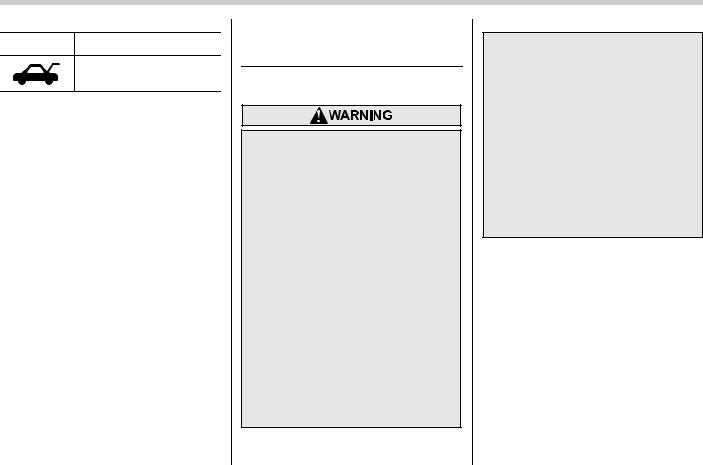
4
Mark |
Name |
Rear gate (Transmitter)
Safety precautions when driving
Seatbelt and SRS airbag
yAll persons in the vehicle should fasten their seatbelts BEFORE the vehicle starts to move. Otherwise, the possibility of serious injury becomes greater in the event of a sudden stop or accident.
yTo obtain maximum protection in the event of an accident, the driver and all passengers in the vehicle should always wear seatbelts when the vehicle is moving. The SRS (Supplemental Restraint System) airbag does not do away with the need to fasten seatbelts. In combination with the seatbelts, it offers the best combined protection in case of a serious accident.
Not wearing a seatbelt increases the chance of severe injury or death in a crash even when the vehicle has the SRS airbag.
yThe SRS airbags deploy with considerable speed and force. Occupants who are out of proper position when the SRS airbag deploys could suffer very serious injuries. Because the SRS airbag needs enough space for deployment, the driver should always sit upright and well back in the seat as far from the steering wheel as practical while still maintaining full vehicle control and the front passenger should move the seat as far back as possible and sit upright and well back in the seat.
Carefully read the sections “Seat, seatbelt and SRS airbags” in chapter 1 of this owner’s manual for instructions and precautions concerning the seatbelt system and SRS airbag system.

Child safety
yNever hold a child on your lap or in your arms while the vehicle is moving. The passenger cannot protect the child from injury in a collision, because the child will be caught between the passenger and objects inside the vehicle.
yWhile riding in the vehicle, infants and small children should always be placed in one of the rear seating positions recommended in this owner’s manual in an infant or child restraint system which is appropriate for the child’s age, height and weight. If a child is too big for a child restraint system, the child should sit in a REAR seat and be restrained using the seatbelts. According to accident statistics, children are safer when properly restrained in the rear seating positions than in the front seating positions. Never allow a child to stand up or kneel on the seat.
yPut children aged 12 and under in a REAR seat properly restrained at all times in a child restraint device or in a seatbelt. The SRS airbag deploys with considerable speed and force and can injure or even kill children, especially if they are 12 years of age and under and are not restrained or improperly restrained. Because children are lighter and weaker than adults, their risk of being injured from deployment is greater.
yNEVER INSTALL A REARWARD FACING CHILD SAFETY SEAT IN THE FRONT SEAT. DOING SO RISKS SERIOUS INJURY OR DEATH TO THE CHILD BY PLACING THE CHILD’S HEAD TOO CLOSE TO THE SRS AIRBAG.
yAlways use the child safety locks whenever a child rides in the rear. Serious injury could result if a child accidentally opened the door and fell out. Refer to the “Door locks” section in chapter 2.
5
yAlways lock the passenger’s windows using the lock switch when children are riding in the vehicle. Failure to follow this procedure could result in injury to a child operating the power window. Refer to the “Power windows” section in chapter 2.
yNever leave unattended children in the vehicle. They could accidentally injure themselves or others through inadvertent operation of the vehicle. Also, on hot or sunny days, temperature in a closed vehicle could quickly become high enough to cause severe or possibly fatal injuries to them.
Carefully read the sections “Child restraint systems”, “*SRS airbag (Supplemental Restraint System airbag)”, and “Seatbelts” in chapter 1 of this owner’s manual for instructions and precautions concerning the child restraint system, seatbelt system and SRS airbag system.
– CONTINUED –

6
Engine exhaust gas (carbon monoxide)
yNever inhale engine exhaust gas. Engine exhaust gas contains carbon monoxide, a colorless and odorless gas which is dangerous, or even lethal, if inhaled.
yAlways properly maintain the engine exhaust system to prevent engine exhaust gas from entering the vehicle.
yNever run the engine in a closed space, such as a garage, except for the brief time needed to drive the vehicle in or out of it.
yAvoid remaining in a parked vehicle for a lengthy time while the engine is running. If that is unavoidable, then use the ventilation fan to force fresh air into the vehicle.
yAlways keep the front ventilator inlet grille free from snow, leaves or other obstructions to ensure that the ventilation system always works properly.
yIf at any time you suspect that exhaust fumes are entering the vehicle, have the problem checked and corrected as soon as possible. If you must drive under these conditions, drive only with all windows fully open.
yKeep the rear gate closed while driving to prevent exhaust gas from entering the vehicle.
Drinking and driving
Drinking and then driving is very dangerous. Alcohol in the bloodstream delays your reaction and impairs your perception, judgment and attentiveness. If you drive after drinking – even if you drink just a little – it will increase the risk of being involved in a serious or fatal accident, injuring or killing yourself, your passengers and others. In addition, if you are injured in the accident, alcohol may increase the severity of that injury.
Please don’t drink and drive.
Drunken driving is one of the most fre-
quent causes of accidents. Since alcohol affects all people differently, you may have consumed too much alcohol to drive safely even if the level of alcohol in your blood is below the legal limit. The safest thing you can do is never drink and drive. However if you have no choice but to drive, stop drinking and sober up completely before getting behind the wheel.
Drugs and driving
There are some drugs (over the counter and prescription) that can delay your reaction time and impair your perception, judgment and attentiveness. If you drive after taking them, it may increase your, your passengers’ and other persons’ risk of being involved in a serious or fatal accident.
If you are taking any drugs, check with your doctor or pharmacist or read the literature that accompanies the medication to determine if the drug you are taking can impair your driving ability. Do not drive after taking any medications that can make you drowsy or otherwise affect your ability to safely operate a motor vehicle. If you

have a medical condition that requires you to take drugs, please consult with your doctor.
Never drive if you are under the influence of any illicit mind-altering drugs. For your own health and well-being, we urge you not to take illegal drugs in the first place and to seek treatment if you are addicted to those drugs.
Driving when tired or sleepy
When you are tired or sleepy, your reaction will be delayed and your perception, judgment and attentiveness will be impaired. If you drive when tired or sleepy, your, your passengers’ and other persons’ chances of being involved in a serious accident may increase.
Please do not continue to drive but instead find a safe place to rest if you are tired or sleepy. On long trips, you should make periodic rest stops to refresh yourself before continuing on your journey. When possible, you should share the driving with others.
Car phone/cell phone and driving
Do not use a car phone/cell phone while driving; it may distract your attention from driving and can lead to an accident. If you use a car phone/ cell phone, pull off the road and park in a safe place before using your phone. In some States/Provinces, only hands-free phones may legally be used while driving.
Modification of your vehicle
Your vehicle should not be modified. Modification could affect its performance, safety or durability, and may even violate governmental regulations. In addition, damage or performance problems resulting from modification may not be covered under warranties.
Driving with pets
Unrestrained pets can interfere with your driving and distract your attention from
7
driving. In a collision or sudden stop, unrestrained pets or cages can be thrown around inside the vehicle and hurt you or your passengers. Besides, the pets can be hurt under these situations. It is also for their own safety that pets should be properly restrained in your vehicle. Restrain a pet with a special traveling harness which can be secured to the rear seat with a seatbelt or use a pet carrier which can be secured to the rear seat by routing a seatbelt through the carrier’s handle. Never restrain pets or pet carriers in the front passenger’s seat. For further information, consult your veterinarian, local animal protection society or pet shop.
Tire pressures
Driving at high speeds with excessively low tire pressures can cause the tires to deform severely and to rapidly become hot. A sharp increase in temperature could cause tread separation, and destruction of the tires. The resulting loss of vehicle control could lead to an accident.
Check and, if necessary, adjust the pres-
– CONTINUED –

8
sure of each tire (including the spare) at least once a month and before any long journey.
Check the tire pressure when the tires are cold.
Use a pressure gauge to adjust the tire pressures to the values shown on the tire placard.
Refer to the “Tires and wheels” section in chapter 11 for detailed information.
California proposition 65 warning
Engine exhaust, some of its constituents, and certain vehicle components contain or emit chemicals known to the State of California to cause cancer and birth defects or other reproductive harm. In addition, certain fluids in vehicles and certain components of product wear contain or emit chemicals known to the State of California to cause cancer and birth defects or other reproductive harm.
On-pavement and off-road driving
This vehicle is classified as a utility vehicle. Utility vehicles have a significantly higher rollover rate than other types of vehicles. Designed not only for on-pavement use but also for off-road driving, your B9 TRIBECA has a higher ground clearance and higher center of gravity, making it more likely to roll over than ordinary passenger cars. It also handles and maneuvers differently from other passenger cars. For this reason, please read carefully the “On-pavement and off road driving” section in chapter 8 of this owner’s manual and follow the instructions and precautions in order to prevent serious injury or death due to loss of control, rollover and other accidents.
Table of contents
Seat, seatbelt and SRS airbags |
1 |
|
|
|
|
Keys and doors |
2 |
|
|
|
|
Instruments and controls |
3 |
|
|
Climate control |
4 |
|
|
Audio |
5 |
|
|
|
|
Interior equipment |
6 |
|
|
|
|
Starting and operating |
7 |
|
|
Driving tips |
8 |
|
|
In case of emergency |
9 |
|
|
|
|
Appearance care |
10 |
|
|
|
|
Maintenance and service |
11 |
|
|
Specifications |
12 |
|
|
Consumer information and Reporting safety defects |
13 |
|
|
|
|
Index |
14 |
|
|

10
Illustrated index |
|
|
|
|
1) |
Engine hood lock release (page 11-4) |
|
|
|
|
|
2) |
Headlight switch (page 3-26) |
Exterior |
|
|
|
|
3) |
Bulb replacement (page 11-39) |
|
|
|
|
4) |
Wiper switch (page 3-30) |
|
1 |
2 |
3 |
4 |
5 |
5) |
Moonroof (page 2-23) |
6) |
Door locks (page 2-4) |
|||||
|
|
|
|
|
7) |
Tire pressure (page 11-25) |
|
|
|
|
|
8) |
Flat tires (page 9-7) |
|
|
|
|
|
9) |
Tire chains (page 8-11) |
|
|
|
|
|
10) |
Fog light switch (page 3-28) |
|
|
|
|
|
11) |
Tie-down hooks (page 9-15) |
|
|
|
|
|
12) |
Towing hook (page 9-15) |
12 |
11 |
10 |
9 |
8 |
7 |
6 |
000085 |
|
|
|
|
|
|
|

|
|
|
|
11 |
|
|
|
1) |
Rear gate (page 2-22) |
|
|
|
2) |
Rear wiper blade assembly and rub- |
1 2 |
3 |
4 |
5 |
ber replacement (page 3-32) |
|
|
|
3) |
Rear window defogger button (page |
|
|
|
|
3-33) |
|
|
|
4) |
Fuel filler lid and cap (page 7-3) |
|
|
|
5) |
Child safety locks (page 2-19) |
|
|
|
6) |
Tie-down hooks (page 9-15) |
|
|
|
7) |
Bulb replacement (page 11-39) |
|
|
|
8) |
Towing hook (page 9-15) |
8 |
7 |
6 |
000105
– CONTINUED –

12
Interior |
|
|
1) |
Seatbelt (page 1-15) |
T Passenger compartment area |
|
2) |
Lower anchorages for child restraint |
|
|
|
system (page 1-38) |
||
|
|
|
|
|
|
|
|
3) |
Center console (page 6-5) |
|
|
|
||
1 |
2 |
1 |
4) |
Front seat (page 1-2) |
|
|
5) |
Second-row seat (page 1-6) |
|
|
|
|
||
|
|
1 |
6) |
Third-row seat (page 1-11) |
6
5
4 |
3 |
000086

13
1 |
2 |
3 |
1) |
Cargo area light (page 6-2) |
2) |
Dome lights (page 6-2) |
|||
|
|
|
3) |
Rear center seatbelt (page 1-22) |
|
|
|
4) |
Sun visors (page 6-3) |
|
|
|
5) |
Map light (page 6-3) |
|
|
|
6) |
Top tether anchorages (Rear seat/ |
|
|
|
|
Second-row seat) (page 1-41) |
|
|
|
7) |
Top tether anchorages (Third-row |
|
|
|
6 |
seat) (page 1-41) |
|
|
|
|
4 5 4
7
000087
– CONTINUED –

14
1 |
2 |
3 |
1) |
Select lever (page 7-9) |
2) |
Hazard warning flasher switch (page |
|||
|
|
|
|
3-5) |
|
|
|
3) |
Multi function display (page 3-23) |
|
|
|
4) |
Glove box (page 6-4) |
|
|
|
5) |
Audio (page 5-1) |
|
|
|
6) |
Climate control (page 4-1) |
|
|
|
7) |
Cup holder (page 6-7/page 6-8) |
7 |
6 |
5 |
4 |
000088 |
|
|
|
|

Instrument panel
1 |
2 |
3 |
4 |
5 |
6 |
7 |
|
8 |
||||||||
|
|
|
|
|
|
|
|
|
|
|
|
|
|
|
|
|
|
|
|
|
|
|
|
|
|
|
|
|
|
|
|
|
|
|
|
|
|
|
|
|
|
|
|
|
|
|
|
|
|
|
|
|
|
|
|
|
|
|
|
|
|
|
|
|
|
|
|
|
|
|
|
|
|
|
|
|
|
|
|
|
|
|
|
|
|
|
|
|
|
|
|
|
|
|
|
|
|
|
|
|
|
|
|
|
|
|
|
|
|
|
|
|
|
|
|
|
|
|
|
|
|
|
|
|
|
|
|
|
|
|
|
|
|
|
|
|
|
|
|
|
|
|
|
|
|
|
|
|
|
|
|
|
|
|
|
|
|
|
|
|
|
|
|
|
|
|
|
|
|
|
|
|
|
|
|
|
|
|
|
|
|
|
|
|
|
|
15 |
14 13 |
12 |
11 10 |
9 |
000106 |
|
|
|
|
|
15
1)Door locks (page 2-4)
2)Illumination brightness control (page 3-27)
3)Remote control mirror (page 3-36)
4)Windshield wiper deicer (page 3-32)
5)Traction Control system OFF switch (page 7-23)
6)Light control lever (page 3-26)
7)Combination meter (page 3-5)
8)Wiper control lever (page 3-29)
9)Cruise control (page 7-27)
10)Horn (page 3-37)
11)SRS airbag (page 1-44)
12)Tilt steering (page 3-37)
13)Hood lock release knob (page 11-4)
14)Fuse box (page 11-36)
15)Power windows (page 2-19)
– CONTINUED –

16
Light control and wiper control levers/switches |
1) |
Parking light switch (page 3-28) |
|
|
|
2) |
Windshield wiper (page 3-29) |
|
|
3) |
Mist (page 3-31) |
|
1 |
4) |
Windshield washer (page 3-30) |
|
|
5) |
Rear window wiper and washer |
|
|
|
switch (page 3-32) |
|
|
6) |
Wiper control lever (page 3-30) |
|
|
7) |
Light control lever (page 3-26) |
|
|
8) |
Fog light switch (page 3-28) |
|
|
9) |
Headlight ON/OFF (page 3-26) |
|
|
10) |
Headlight flasher High/Low beam |
|
|
|
change (page 3-26) |
|
9 |
11) |
Turn signal (page 3-27) |
11 |
5 |
4 |
|
10 |
|
||
|
3 |
|
|
|
|
|
|
|
8 |
|
|
|
|
2 |
|
7 |
6 |
000107
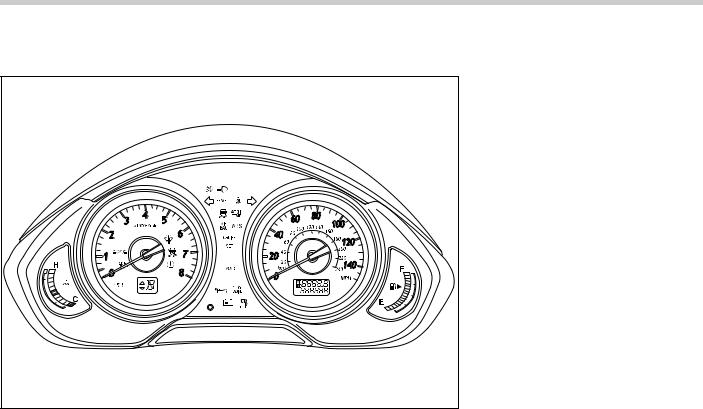
Combination meter
T U.S.-spec. vehicles
1 |
2 |
|
|
3 |
4 |
|||||
|
|
|
|
|
|
|
|
|
|
|
|
|
|
|
|
|
|
|
|
|
|
|
|
|
|
|
|
|
|
|
|
|
|
|
|
|
|
|
|
|
|
|
|
|
|
|
|
|
|
|
|
|
|
|
|
|
|
|
|
|
|
|
|
|
|
|
|
|
|
|
|
|
|
|
|
|
|
|
|
|
|
|
|
|
|
|
|
7 |
6 |
5 |
000110
17
1)Temperature gauge (page 3-8)
2)Tachometer (page 3-7)
3)Speedometer (page 3-6)
4)Fuel gauge (page 3-8)
5)Trip meter and odometer (page 3-6/ page 3-7)
6)Trip meter A/B selection and trip meter reset knob (page 3-7)
7)Selector lever/Gear position indicator (page 3-20)
– CONTINUED –

18
T Canada-spec. vehicles
1 |
2 |
|
|
3 |
4 |
|||||
|
|
|
|
|
|
|
|
|
|
|
|
|
|
|
|
|
|
|
|
|
|
|
|
|
|
|
|
|
|
|
|
|
|
|
|
|
|
|
|
|
|
|
|
|
|
|
|
|
|
|
|
|
|
|
|
|
|
|
|
|
|
|
|
|
|
|
|
|
|
|
|
|
|
|
|
|
|
|
|
|
|
|
|
|
|
|
|
7 |
6 |
5 |
000111
1)Temperature gauge (page 3-8)
2)Tachometer (page 3-7)
3)Speedometer (page 3-6)
4)Fuel gauge (page 3-8)
5)Trip meter and odometer (page 3-6/ page 3-7)
6)Trip meter A/B selection and trip meter reset knob (page 3-7)
7)Selector lever/Gear position indicator (page 3-20)
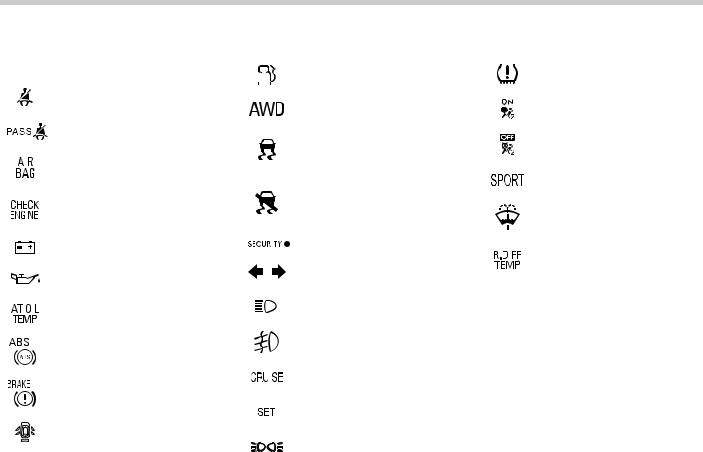
19
Warning and indicator light |
|
|
|
|
|
|
|
|
|
|
|
|
|
|
|
|
|
|
||||||||
|
|
Mark |
|
Name |
Page |
|
Mark |
|
Name |
Page |
||||||||||||||||
|
|
|
|
|
|
|
|
|
|
|
|
|
|
|
|
|
|
|
|
|
|
|
|
|
|
|
Mark |
Name |
Page |
|
|
|
|
|
|
|
|
|
Low fuel warning light |
3-17 |
|
|
|
|
Low |
tire |
pressure |
3-14 |
|||||
|
|
|
|
|
|
|
|
|
|
|
|
|
|
|
|
|
|
|
warning light |
|
||||||
|
|
|
Driver’s seatbelt warn- |
3-10 |
|
|
|
|
|
|
|
|
|
|
|
|
|
|
|
|
|
|
|
|
||
|
|
|
|
|
|
|
|
|
|
|
|
|
|
|
|
|
|
|
|
|
|
|
|
|
||
|
|
|
|
|
|
|
|
|
|
|
|
|
|
|
|
|
|
|
|
|
|
|
|
|
||
|
|
|
ing light |
|
|
|
|
|
|
|
|
|
|
All-Wheel Drive warn- |
3-17 |
|
|
|
|
Passenger airbag ON |
3-12 |
|||||
|
|
|
|
|
|
|
|
|
|
|
|
|
|
|
|
|
|
|||||||||
|
|
|
|
|
|
|
|
|
|
|
|
|
|
|
ing light |
|
|
|
|
|
indicator light |
|
||||
|
|
|
Front passenger’s |
3-10 |
|
|
|
|
|
|
|
|
|
|
|
|
|
|
|
|
|
|
||||
|
|
|
|
|
|
|
|
|
|
|
|
|
|
|
|
|
|
|
|
|
|
|
|
|
||
|
|
|
|
|
|
|
|
|
|
|
|
|
|
|
|
|
|
|
|
|
|
|
|
|
||
|
|
|
seatbelt warning light |
|
|
|
|
|
|
|
|
|
|
Vehicle Dynamics |
|
|
|
|
|
Passenger airbag OFF |
3-12 |
|||||
|
|
|
|
|
|
|
|
|
|
|
|
|
|
|
|
|
|
|
||||||||
|
|
|
|
|
|
|
|
|
|
|
|
|
|
|
Control operation indi- |
3-18 |
|
|
|
|
indicator light |
|
||||
|
|
|
SRS airbag system |
|
|
|
|
|
|
|
|
|
|
|
|
|
|
|
|
|
||||||
|
|
|
3-11 |
|
|
|
|
|
|
|
|
|
|
cator light |
|
|
|
|
|
|
|
|
|
|
||
|
|
|
|
|
|
|
|
|
|
|
|
|
|
|||||||||||||
|
|
|
|
|
|
|
|
|
|
|
|
|
|
|
|
|
|
|
|
|
|
|
||||
|
|
|
warning light |
|
|
|
|
|
|
|
|
|
|
|
|
|
|
|
|
|
|
SPORT mode indica- |
3-19 |
|||
|
|
|
|
|
|
|
|
|
|
|
|
|
|
Vehicle |
Dynamics |
|
|
|
|
|
||||||
|
|
|
|
|
|
|
|
|
|
|
|
|
|
|
|
|
|
|
|
tor light |
|
|
||||
|
|
|
|
|
|
|
|
|
|
|
|
|
|
|
|
|
|
|
|
|
|
|
||||
|
|
|
CHECK ENGINE |
|
|
|
|
|
|
|
|
|
|
|
Control warning light / |
3-18 |
|
|
|
|
|
|
|
|
||
|
|
|
|
|
|
|
|
|
|
|
|
|
|
|
|
|
|
|
|
|
|
|||||
|
|
|
warning light/Malfunc- |
3-12 |
|
|
|
|
|
|
|
|
|
|
Traction Control sys- |
|
|
|
|
Windshield washer flu- |
|
|||||
|
|
|
|
|
|
|
|
|
|
|
|
|
|
|
|
|
|
3-17 |
||||||||
|
|
|
tion indicator lamp |
|
|
|
|
|
|
|
|
|
|
|
tem OFF indicator light |
|
|
|
|
|
id warning light |
|||||
|
|
|
|
|
|
|
||||||||||||||||||||
|
|
|
|
|
|
|
|
|
|
|
|
|
|
|
Security indicator light |
3-19 |
|
|
|
|
|
|
|
|
||
|
|
|
Charge warning light |
3-13 |
|
|
|
|
|
|
|
|
|
|
|
|
|
|
|
|
|
|
||||
|
|
|
|
|
|
|
|
|
|
|
|
|
|
|
|
|
Rear |
differential oil |
|
|||||||
|
|
|
|
|
|
|
|
|
|
|
|
|
|
|
|
|
|
|||||||||
|
|
|
|
|
|
|
|
|
|
|
|
|
|
|
|
|
|
|
|
|
|
|||||
|
|
|
|
|
|
|
|
|
|
|
|
|
|
|
|
|
|
|
|
|
|
|
temperature |
warning |
3-14 |
|
|
|
|
|
|
|
|
|
|
|
|
|
|
|
|
Turn |
signal |
indicator |
|
|
|||||||
|
|
|
|
|
|
|
|
|
|
|
|
|
|
|
|
|
|
|
|
|||||||
|
|
|
Oil pressure warning |
|
|
|
|
|
|
|
|
|
|
|
3-20 |
|
|
|
|
light |
|
|
|
|||
|
|
|
3-13 |
|
|
|
|
|
|
|
|
|
|
lights |
|
|
|
|
|
|
|
|
|
|||
|
|
|
light |
|
|
|
|
|
|
|
|
|
|
|
|
|
|
|
|
|
|
|
|
|
||
|
|
|
|
|
|
|
|
|
|
|
|
|
|
|
|
|
|
|
|
|
|
|
|
|
|
|
|
|
|
|
|
|
|
|
|
|
|
|
|
|
|
High |
beam |
indicator |
3-20 |
|
|
|
|
|
|
|
|
|
|
|
AT OIL temperature |
|
|
|
|
|
|
|
|
|
|
|||||||||||||
|
|
|
3-13 |
|
|
|
|
|
|
|
|
|
|
light |
|
|
|
|
|
|
|
|
|
|
||
|
|
|
warning light |
|
|
|
|
|
|
|
|
|
|
|
|
|
|
|
|
|
|
|
|
|
||
|
|
|
|
|
|
|
|
|
|
|
|
|
|
|
|
|
|
|
|
|
|
|
|
|
|
|
|
|
|
|
|
|
|
|
|
|
|
|
|
|
|
Front fog light indicator |
3-20 |
|
|
|
|
|
|
|
|
||
|
or |
|
|
|
|
|
|
|
|
|
|
|
||||||||||||||
|
ABS warning light |
3-15 |
|
|
|
|
|
|
|
|
|
|
light |
|
|
|
|
|
|
|
|
|
|
|||
|
|
|
|
|
|
|
|
|
|
|
|
|
|
|
|
|
|
|
|
|
|
|
|
|||
|
|
|
|
|
|
|
|
|
|
|
|
|
|
|
|
|
|
|
|
|
|
|
|
|
||
|
|
|
|
|
|
|
|
|
|
|
|
|
|
|
Cruise control indica- |
3-20 |
|
|
|
|
|
|
|
|
||
|
|
|
|
|
|
|
|
|
|
|
|
|
|
|||||||||||||
|
|
or |
Brake system warning |
|
|
|
|
|
|
|
|
|
|
|
tor light |
|
|
|
|
|
|
|
|
|
||
|
|
3-16 |
|
|
|
|
|
|
|
|
|
|
|
|
|
|
|
|
|
|
|
|
||||
|
|
|
light |
|
|
|
|
|
|
|
|
|
|
|
|
|
|
|
|
|
|
|
|
|
|
|
|
|
|
|
|
|
|
|
|
|
|
|
|
Cruise control set indi- |
3-20 |
|
|
|
|
|
|
|
|
||||
|
|
|
|
|
|
|
|
|
|
|
|
|
|
|
|
|
|
|
|
|
|
|||||
|
|
|
|
|
|
|
|
|
|
|
|
|
|
|
|
|
|
|
|
|
|
|
||||
|
|
|
|
|
|
|
|
|
|
|
|
|
|
|
cator light |
|
|
|
|
|
|
|
|
|
||
|
|
|
Door open warning |
3-17 |
|
|
|
|
|
|
|
|
|
|
|
|
|
|
|
|
|
|
||||
|
|
|
|
|
|
|
|
|
|
|
|
|
|
|
|
|
|
|
|
|
|
|
||||
|
|
|
|
|
|
|
|
|
|
|
|
|
|
|
|
|
|
|
|
|
|
|
|
|
||
|
|
|
light |
|
|
|
|
|
|
|
|
|
|
Headlight indicator |
3-20 |
|
|
|
|
|
|
|
|
|||
|
|
|
|
|
|
|
|
|
|
|
|
|
|
|
|
|
|
|
|
|
|
|||||
|
|
|
|
|
|
|
|
|
|
|
|
|
|
|
light |
|
|
|
|
|
|
|
|
|
|
|
|
|
|
|
|
|
|
|
|
|
|
|
|
|
|
|
|
|
|
|
|
|
|
|
|
||
|
|
|
|
|
|
|
|
|
|
|
|
|
|
|
|
|
|
|
|
|
|
|
|
|
|
|
|
|
|
|
|
|
|
|
|
|
|
|
|
|
|
|
|
|
|
|
|
|
|
|
|
|
|
|
|
|
|
|
|
|
|
|
|
|
|
|
|
|
|
|
|
|
|
|
|
|
|
|
|
|
– CONTINUED –
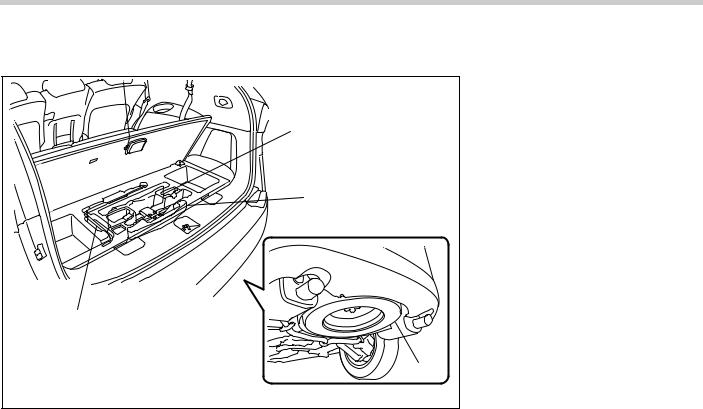
20
Cargo area
T 7-seater models |
2 |
3 |
1 |
4 |
000089 |
1)Jack handle (page 9-19)
2)Maintenance tools (page 9-19)
3)Jack (page 9-19)
4)Spare tire (page 9-2)

T 5-seater models |
|
|
1 |
2 |
3 |
|
|
4 |
|
|
000148 |
21
1)Jack handle (page 9-19)
2)Jack (page 9-19)
3)Maintenance tools (page 9-19)
4)Spare tire (page 9-2)
– CONTINUED –

22
Function settings
A SUBARU dealer can change the settings of the functions shown in the following table to meet your personal requirements. Contact the nearest SUBARU dealer for details. If your vehicle is equipped with navigation system, the settings for some of these functions can be changed using the monitor. For details, please refer to the Owner’s Manual supplement for the monitor.
Item |
Function |
Possible settings |
Default setting |
Page |
|
|
|
|
|
Alarm system |
Alarm system |
Operation / Non-operation |
Operation |
2-14 |
|
|
|
|
|
|
Monitoring start delay time (after closure of |
0 second / 30 seconds |
30 seconds |
2-16 |
|
doors) |
|
|
|
|
|
|
|
|
|
Impact sensor operation (only vehicles |
Operation / Non-operation |
Non-operation |
2-18 |
|
with shock sensors (dealer option)) |
|
|
|
|
|
|
|
|
|
Passive arming |
Operation / Non-operation |
Non-operation |
2-17 |
|
|
|
|
|
Remote keyless entry system |
Hazard warning flasher |
Operation / Non-operation |
Operation |
2-8 |
|
|
|
|
|
|
Audible signal |
Operation / Non-operation |
Operation |
2-10 |
|
|
|
|
|
Key lock-in prevention |
Key lock-in prevention |
Operation / Non-operation |
Operation |
2-6 |
|
|
|
|
|
Rear window defogger |
Rear window defogger |
Operation for 15 min. / Continuous opera- |
Operation for |
3-33 |
|
|
tion |
15 min. |
|
|
|
|
|
|
Windshield wiper deicer (if |
Windshield wiper deicer |
Operation for 15 min. / Continuous opera- |
Operation for |
3-32 |
equipped) |
|
tion |
15 min. |
|
|
|
|
|
|
Map light/Dome light |
Operation in interlock with remote keyless |
OFF / Short / Normal / Long |
Normal |
6-2 |
|
entry system |
|
|
|
|
|
|
|
|
Battery drainage prevention func- |
Battery drainage prevention function |
Operation / Non-operation |
Operation |
2-6 |
tion |
|
|
|
|
|
|
|
|
|
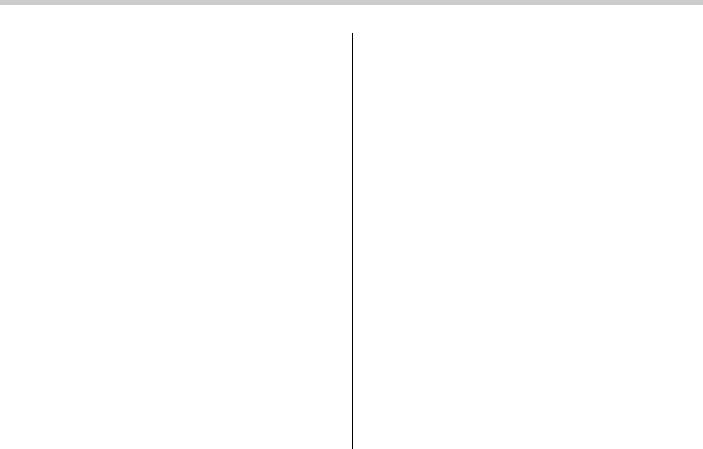
Seat, seatbelt and SRS airbags
Front seats .......................................................... |
1-2 |
Power seat ............................................................... |
1-3 |
Reclining the seatback ........................................... |
1-3 |
Head restraint adjustment ..................................... |
1-4 |
Active head restraint .............................................. |
1-5 |
Lumbar support ...................................................... |
1-5 |
Seat heater (if equipped) ................................... |
1-6 |
Rear seats (5-seater models)/Second-row |
|
seats (7-seater models) .................................. |
1-6 |
Fore and aft adjustment ......................................... |
1-7 |
Reclining the seatback ........................................... |
1-8 |
Folding down the seatback .................................... |
1-9 |
Head restraint adjustment ..................................... |
1-10 |
Armrest .................................................................... |
1-11 |
Third-row seat (7-seater models) ...................... |
1-11 |
Access to the third-row seat .................................. |
1-12 |
Folding down the seatback .................................... |
1-13 |
Head restraint adjustment ..................................... |
1-14 |
Seatbelts ............................................................. |
1-15 |
Seatbelt safety tips ................................................. |
1-15 |
Emergency Locking Retractor (ELR) .................... |
1-16 |
Automatic/Emergency Locking Retractor |
|
(A/ELR) .................................................................. |
1-16 |
Seatbelt warning light and chime .......................... |
1-17 |
Fastening the seatbelt ............................................ |
1-18 |
Seatbelt maintenance ............................................. |
1-26 |
Front seatbelt pretensioners ............................. |
1-27 |
System monitors .................................................... |
1-28 |
System servicing .................................................... |
1-29 |
............Precautions against vehicle modification |
1-29 |
1 |
......................................Child restraint systems |
1-30 |
|
Where to place a child restraint system ............... |
1-31 |
|
Choosing a child restraint system ........................ |
1-33 |
|
Installing child restraint systems with A/ELR |
|
|
seatbelt .................................................................. |
1-33 |
|
Installing a booster seat ......................................... |
1-37 |
|
Installation of child restraint systems by use of |
|
|
lower and tether anchorages (LATCH) ............... |
1-38 |
|
Top tether anchorages ........................................... |
1-41 |
|
*SRS airbag (Supplemental Restraint System |
|
|
airbag) .............................................................. |
1-44 |
|
Your vehicle’s SRS configuration ......................... |
1-44 |
|
Subaru advanced frontal airbag system .............. |
1-49 |
|
SRS side airbag and SRS curtain airbag .............. |
1-59 |
|
SRS airbag system monitors ................................. |
1-66 |
|
SRS airbag system servicing ................................ |
1-67 |
|
Precautions against vehicle modification ............ |
1-68 |
|
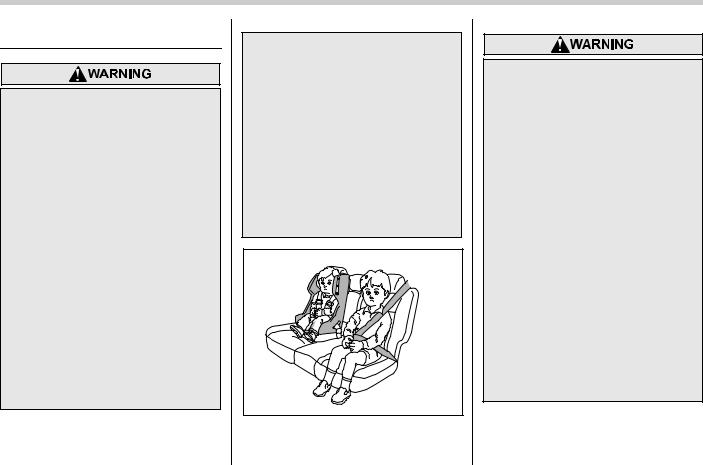
1-2 Seat, seatbelt and SRS airbags
Front seats
yNever adjust the seat while driving to avoid the possibility of loss of vehicle control and of personal injury.
yBefore adjusting the seat, make sure the hands and feet of rear seat passengers are clear of the adjusting mechanism.
ySeatbelts provide maximum restraint when the occupant sits well back and upright in the seat. To reduce the risk of sliding under the seatbelt in a collision, the front seatbacks should be always used in the upright position while the vehicle is running. If the front seatbacks are not used in the upright position in a collision, the risk of sliding under the lap belt and of the lap belt sliding up over the abdomen will increase, and both can result in serious internal injury or death.
yThe SRS airbags deploy with considerable speed and force. Occupants who are out of proper position when the SRS airbag deploys could suffer very serious injuries. Because the SRS airbag needs enough space for deployment, the driver should always sit upright and well back in the seat as far from the steering wheel as practical while still maintaining full vehicle control and the front passenger should move the seat as far back as possible and sit upright and well back in the seat.
100350
Put children aged 12 and under in a rear seat properly restrained at all times. The SRS airbag deploys with considerable speed and force and can injure or even kill children, especially if they are 12 years of age and under and are not restrained or improperly restrained. Because children are lighter and weaker than adults, their risk of being injured from deployment is greater. Consequently, we strongly recommend that ALL children (including those in child seats and those that have outgrown child restraint devices) sit in a REAR seat properly restrained at all times in a child restraint device or in a seatbelt, whichever is appropriate for the child’s age, height and weight.
Always secure ALL types of child restraint devices (including forward facing child seats) in one of the rear seating positions recommended in this owner’s manual.

NEVER INSTALL A REARWARD FACING CHILD SEAT IN THE FRONT SEAT. DOING SO RISKS SERIOUS INJURY OR DEATH TO THE CHILD BY PLACING THE CHILD’S HEAD TOO CLOSE TO THE SRS AIRBAG.
According to accident statistics, children are safer when properly restrained in the rear seating positions than in the front seating positions. For instructions and precautions concerning child restraint systems, see the “Child restraint systems” section in this chapter.
Power seat
T Fore and aft adjustment
100351
To adjust the seat forward or backward, move the control switch forward or backward.
NOTE
During backward-forward adjustment of the seat, you cannot adjust the seat cushion angle or seat height.
Reclining the seatback
100085
Seat, seatbelt and SRS airbags 1-3
To prevent the passenger from sliding under the seatbelt in the event of a collision, always put the seatback in the upright position while the vehicle is in motion. Also, do not place objects such as cushions between the passenger and the seatback. If you do so, the risk of sliding under the lap belt and of the lap belt sliding up over the abdomen will increase, and both can result in serious internal injury or death.
100354
To adjust the angle of the seatback, move the control switch.
– CONTINUED –

1-4 Seat, seatbelt and SRS airbags
TSeat cushion angle adjustment (Driver’s seat only)
100352
To adjust the seat cushion angle, pull up or push down the front end of the control switch.
TSeat height adjustment (Driver’s seat only)
100353
To adjust the seat height, pull up or push down the rear end of the control switch.
Head restraint adjustment
100355
To raise the head restraint, pull it up. To lower it, push the head restraint down while pressing the release button on the top of the seatback.
The head restraint should be adjusted so that the center of the head restraint is closest to the top of the occupant’s ears.
Never drive the vehicle with the head restraints removed because they are designed to reduce the risk of serious neck injury in the event that the vehicle is struck from the rear.
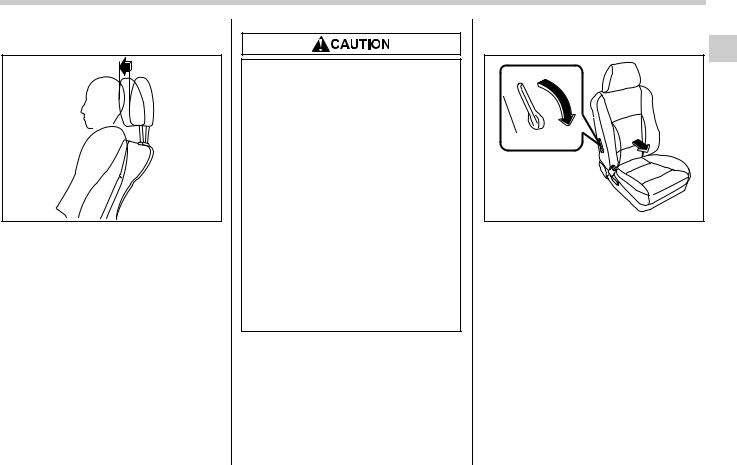
Active head restraint
100089
The front seats of your vehicle are equipped with active head restraints. They automatically tilt forward slightly in the event the vehicle is struck from the rear, decreasing the amount of rearward head movement and thus reducing the risk of whiplash. For maximum effectiveness the head restraint should be adjusted so that the center of the head restraint is closest to the top of the occupant’s ears.
yEach active head restraint is effective only when its height is properly adjusted and the driver/ passenger sits in the correct position on the seat.
yIf your vehicle is involved in a rear-end collision, have an authorized SUBARU dealer inspect the active head restraints.
yThe active head restraints may not operate in the event the vehicle experiences only a slight impact in the rear.
yThe active head restraints may be damaged if they are pushed hard from behind or subjected to shock. As a result, they may not function if the vehicle suffers a rear impact.
Seat, seatbelt and SRS airbags 1-5
Lumbar support
100356
Pull the lever forward or backward. Pulling the lever forward will increase the amount of support for your lower back.
